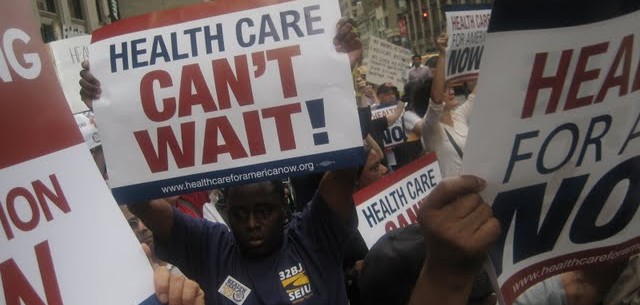Last month, after a YEARS-LONG delay, House or Representatives’ Speaker Paul Ryan and his Republican majority colleagues FINALLY released their “repeal and replace” plan for health care reform, should they maintain control of the House in this fall’s elections along with their Senate colleagues, and a Republican be elected President. Their plan, dubbed “A Better Way”, would essentially return the nation to pre-Affordable Care Act days, while moving in additional conservative, market-driven/oriented directions, and giving private insurance much more hegemony and free rein.
Much of the document is nothing but political rhetoric and “Obamacare bashing”, offering few policy specifics. Here’s the main elements:
General Insurance Reforms:
- Allow Insurers to offer plans across state lines.
- Promote “health savings accounts” (HSAs) and “consumer-directed” plans.
- Return health insurance regulation to the states, repealing the role of federal government.
- Establish (undefined) “State Innovation Grants” to lower premium costs and/or number of uninsured.
Individual Market Reforms:
Repeal the Affordable Care Act but…
- Allow young adults to stay on their parents’ plan
- Prohibit insurers from charging higher premiums to those with pre-existing conditions
- Prohibit insurers from dropping coverage for people who get sick
- Continue bans on lifetime coverage limits
- Eliminate the “individual mandate” tax penalty
- Eliminate state-based and federal “public” health insurance exchanges/marketplaces, along with the advanced premium tax credits (APTCs) to help the uninsured purchase insurance. Instead provide a fixed/flat tax credit to everyone in the individual market, adjusted by age, who would buy coverage through “private exchanges”.
- Prohibit insurers from charging higher rates to people with pre-existing conditions provided they keep continuous coverage.
- Provide a one-time open enrollment period for the uninsured regardless of health history.
- Establish separate state-based high-risk insurance pools for people with pre-existing conditions, for people who have breaks in coverage.
- Allow insurers to charge more to older people for the same plan/policy, beyond the current ACA standard of 3:1 ratio. Standard range would be 5:1 with state flexibility to go higher or lower.
- Unclear: What happens to 20M people currently covered under the new ACA plans?
Employer-Sponsored Coverage Reforms:
- End the “employer mandate” tax penalty.
- Cap the tax preference and tax deduction for employer-sponsored coverage.
- Allow employers to reward employees who participate in wellness programs.
- Allow small businesses and individuals to join together in “association” health plans.
- Allow small employers who self-insure to buy private “stop-loss” coverage.
Medicare Reforms:
- Raise eligibility age to 67 (matching Social Security.)
- Transform Medicare from a “guaranteed benefit” to a “defined contribution”/”premium support” program, with lower premiums for sicker people, lower out-of-pocket limits for low-income people, and higher premiums for wealthier beneficiaries.
- Create regional “Medicare Compare” websites/exchanges to list private Medicare plans and traditional Medicare.
- Combine Medicare Parts A and B, with a unified deductible, and a maximum annual out-of-pocket cost cap.
- Combine all four current Medicare Savings Plans (“MSPs”) into one program with a uniform asset test, to be run/set by states.
- Eliminates the new ACA-authorized “Independent Payment Advisory Board” (not yet implemented), and new the Center for Medicare and Medicaid Innovation.
- End mandatory cuts in subsidies to private Medicare Advantage plans.
- Allow private Medicare Advantage plans greater flexibility to offer “value-based” benefit designs.
- End “first dollar coverage” for private Medicare Supplemental (“Medigap”) plans.
- Allow physicians to enter into private financial contracts with Medicare patients for selected medical services covered by Medicare, but outside of Medicare per se.
- Repeal Medicare Disproportionate Share (“DSH”) cuts to hospitals for 2018-2019.
Medicaid Reforms:
- Transform Medicaid into a block grant program to states. States could choose either a “per-capita cap” or straight block grant.
- Eliminate many coverage requirements for state Medicaid programs.
- Allow states to create incentives for various healthier and personal behaviors.
- Repeal Medicaid Disproportionate Share (“DSH”) cuts for 2018-2020.
Health Insurance Tax Reforms:
Repeals new ACA funding streams:
- Excise (“Cadillac”) tax on high-cost, employer-sponsored/union health plans
- Increased Medicare taxes on high-income taxpayers, including investment income
- Penalties for non-qualified distributions from HSAs
- “Windfall profits” taxes on insurers, drug makers, and medical device manufacturers
Other Reforms:
- Combine Medicare and Medicaid “Disproportionate Share” (DSH) funds into one pool/program starting in 2021.
- Cap medical malpractice awards.
- Codify the anti-choice “Hyde Amendment” and “conscience clauses” for providers.
- Allow physician-owned hospitals.
- Reduce regulation of NIH research.
- Promote “personalized medicine”.
- Modernize clinical trials and reduce red tape.
- Reduce regulation of medical app development.
- Facilitate repurposing of drugs for patients with rare diseases.
- Reduce regulation on development of electronic health records.
Summary: http://abetterway.speaker.gov/_assets/pdf/ABetterWay-HealthCare-Snapshot.pdf
Full document: http://abetterway.speaker.gov/_assets/pdf/ABetterWay-HealthCare-PolicyPaper.pdf


